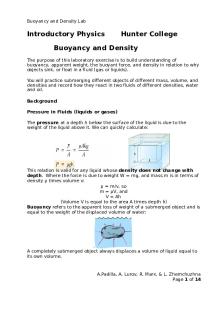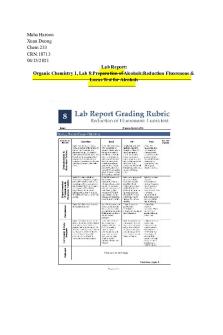Orgo 2 Lab 10 - Lab Report 10 PDF

| Title | Orgo 2 Lab 10 - Lab Report 10 |
|---|---|
| Course | Organic Chemistry II |
| Institution | Temple University |
| Pages | 4 |
| File Size | 278.4 KB |
| File Type | |
| Total Downloads | 21 |
| Total Views | 184 |
Summary
Lab Report 10...
Description
Experiment F1: An Aldol Reaction: trans-4-Nitrochalcone Purpose The purpose of this experiment is to perform a base-catalyzed aldol reaction via the condensation of an aromatic aldehyde with an aryl alkyl ketone. This initial addition reaction will be followed by a dehydration reaction in order to yield a chalcone, or an ɑ,β-unsaturated ketone. The desired product will be isolated using a Hirsch funnel and analyzed by obtaining both an melting point and an IR spectrum. Experimental Procedure Experiment F1 was followed as described in Mayo, pages 351-354, with the modifications listed in the Canvas document. Reaction Scheme
Calculations Theoretical Yield of trans-4-Nitrochalcone Limiting Reactant [R] --- 4-Nitrobenzaldehyde 110 mg 110 mg ×
1𝑔 1000 𝑚𝑔
×
1 𝑚𝑜𝑙 𝑅 151.12 𝑔
×
1 𝑚𝑜𝑙 𝑃 1 𝑚𝑜𝑙 𝑅
×
253.25 𝑔 1 𝑚𝑜𝑙 𝑃
= 0.1843 grams --- 184 mg
Actual Yield of trans-4-Nitrochalcone Weighed directly on weighing paper --- 150 mg of trans-4-Nitrochalcone % Yield of Benzoic Acid (Experimental Yield / Theoretical Yield) x 100 = 150 𝑚𝑔 184 𝑚𝑔
x 100 = 81.52 ---- 81.5% Yield
Data and Results Compound
Mol. Weight
Amount
mmol
M.P. (℃)
B.P.
Density
(g/mol) Acetophenone
120.16
95% Ethanol 4-Nitrobenzaldehyde
0.86
20.7
4 mL 151.12
10% NaOH Trans-4Nitrochalcone
100 μL
110 mg
0.73
103-106
EY) 0.59 TY) 0.73
158-160
(℃)
(g/mL)
202.6
1.03
78.5
0.789
300
400 μL 253.25
EY) 150 mg TY) 184 mg
Observations ● Mixing all reactantants resulted in a clear liquid ● Upon dissolving the aldehyde, the solution turned a pale yellow ● The mixture turned orange and a solid precipitated after the addition of the NaOH solution ● Following the ethanol wash, the product appeared as pale yellow crystals ● Melting Point Range 153-158 ℃ Questions 1) Mechanism
2) A. 400 μL is equivalent to 1 mmol of NaOH B. 100 μL is equivalent to 0.25 mmols of NaOH
C. Given that NaOH serves as the base that catalyzes the production of the product, using a smaller amount will still make the reaction go to completion. However, the smaller quantity of the base will translate to a lower yield of the product as some of the initial reagents will remain unreacted. Therefore, in order to maximize yield and for the sake of their grades, the students should rerun the experiment with 400 μL. 3) A. 1658 cm-1 B. The carbonyl stretch is 23 cm-1 off from the starting ketone of acetophenone. This is due to the conjugation of the alkene next to the carbonyl. The double bond delocalizes electrons over a greater area of the molecule, resulting in a smaller wave number than seen in acetophenone (which lacks the alkene).
4) A. Intermediate B. Based on the NMR data, there is no intermediate that was contained within the isolated product. In the NMR, the signals for 11 Hydrogen are shown, which corresponds to the exact number of Hydrogens present in the desired product. In the intermediate, 13 Hydrogens are present which means the peak integration of the given NMR does not correlate to this molecule. Therefore, only the product present was Trans-4-Nitrochalcone
5) 1
H NMR Spectra for Trans-4-Nitrochalcone
Protons in Molecule
Peak Frequency (ppm)
Peak Multiplicity
Peak Integration
A
8.15
d, J = 8.5
2
B
7.98
J = 15.7 Hz
1
C
7.85
d, J = 8.5
2
D
7.51
m
5
E
6.98
J = 15.7 Hz
1
Works Cited
Mayo, D. W.; Pike, R. M.; Forbes, D. C. Microscale Organic Laboratory with Multistep and Multiscale Syntheses, 5th ed.; John Wiley & Sons, Inc., 2011; pp 7W38-7W41. Modifications for Experiment F1: Aldol Reaction: trans-4-Nitrochalcone, Canvas document....
Similar Free PDFs

Orgo 2 Lab 10 - Lab Report 10
- 4 Pages

Lab 10 - Lab 10 Report
- 7 Pages

Lab 10 - Lab 10
- 17 Pages

Chem lab 10 - lab report
- 9 Pages

Phys lab 10 - Lab report
- 14 Pages

Orgo 2 lab 4 - Lab report
- 14 Pages

Orgo Post-lab 8 - Orgo- Lab report
- 14 Pages

Orgo 2 Lab 3 - Lab report 3
- 5 Pages

Orgo 2 lab 5 - lab report
- 6 Pages

Post Lab Report 10
- 8 Pages

Orgo 2 lab 1 - Lab report
- 4 Pages

Programming Lab Report 10
- 8 Pages

Lab Report 10
- 8 Pages

Lab Report 10
- 9 Pages

Online Lab Report 10
- 7 Pages
Popular Institutions
- Tinajero National High School - Annex
- Politeknik Caltex Riau
- Yokohama City University
- SGT University
- University of Al-Qadisiyah
- Divine Word College of Vigan
- Techniek College Rotterdam
- Universidade de Santiago
- Universiti Teknologi MARA Cawangan Johor Kampus Pasir Gudang
- Poltekkes Kemenkes Yogyakarta
- Baguio City National High School
- Colegio san marcos
- preparatoria uno
- Centro de Bachillerato Tecnológico Industrial y de Servicios No. 107
- Dalian Maritime University
- Quang Trung Secondary School
- Colegio Tecnológico en Informática
- Corporación Regional de Educación Superior
- Grupo CEDVA
- Dar Al Uloom University
- Centro de Estudios Preuniversitarios de la Universidad Nacional de Ingeniería
- 上智大学
- Aakash International School, Nuna Majara
- San Felipe Neri Catholic School
- Kang Chiao International School - New Taipei City
- Misamis Occidental National High School
- Institución Educativa Escuela Normal Juan Ladrilleros
- Kolehiyo ng Pantukan
- Batanes State College
- Instituto Continental
- Sekolah Menengah Kejuruan Kesehatan Kaltara (Tarakan)
- Colegio de La Inmaculada Concepcion - Cebu
